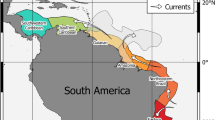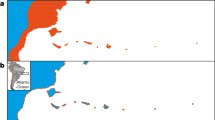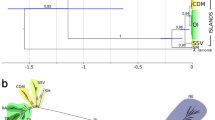Abstract
Dispersal is fundamental to the colonization of oceanic islands that were never connected to larger landmasses. For species with limited dispersal capabilities, colonization of remote islands can be followed by isolation and speciation. The tidepool fish community of Trindade Island, 1,160 km off the Brazilian coast at the eastern end of the Vitória-Trindade Chain, is composed of 18 species from 11 families. Four endemics accounted for 48 % of the total number and 10 % of the total fish weight in tidepools. The fact that the five species confirmed to be endemic to Trindade are restricted to intertidal and shallow waters indicate that in the present interglacial period the seamounts of the Vitória-Trindade Chain do not allow dispersal following a stepping-stones model. Thus, seamounts must have been used as stepping-stones when emerged during lower sea-level periods of the Pleistocene, but this connection was definitively interrupted when they became submerged at the end of the last glaciation. This highlights the importance of considering sea level fluctuations as a structuring factor of intertidal and shallow water communities at oceanic localities.



Similar content being viewed by others
References
Almeida FFM (2006) Ilhas oceânicas brasileiras e suas relações com a tectônica atlântica. Terræ Didatica 2(1):3–18
Arakaki S, Tokeshi M (2011) Analysis of spatial niche structure in coexisting tidepool fishes: null models based on multi-scale experiments. J Anim Ecol 80(1):137–147. doi:10.1111/j.1365-2656.2010.01749.x
Barlow GW (1999) Fish life on the littoral edge. In: Almada VC, Oliveira RF, Gonçalves EJ (eds) Behaviour and conservation of littoral fishes. ISPA, Lisboa, pp 3–32
Barreiros JP, Bertoncini Á, Machado L, Hostim-Silva M, Santos RS (2004) Diversity and seasonal changes in the ichthyofauna of rocky tidal pools from Praia Vermelha and São Roque, Santa Catarina. Braz Arch Biol Technol 47:291–299. doi:10.1590/S1516-89132004000200017
Barton MG (1982) Intertidal vertical distribution and diets of five species of central California stichaeoid fishes. Calif Fish Game 68:174–182
Bennett BA, Griffith CL (1984) Factors affecting the distribution, abundance and diversity of rock-pool fishes on the Cape Peninsula, South Africa. S Afr J Zool 19:97–104
Briggs JC, Bowen BW (2012) A realignment of marine biogeographic provinces with particular reference to fish distributions. J Biogeogr 39(1):12–30. doi:10.1111/j.1365-2699.2011.02613.x
Castellanos-Galindo GA, Giraldo A, Rubio EA (2005) Community structure of an assemblage of tidepool fishes on a tropical eastern Pacific rocky shore, Colombia. J Fish Biol 67:392–408. doi:10.1111/j.1095-8649.2005.00735.x
Cordani UG (1970) Idade do vulcanismo no Oceano Atlântico Sul. Bol Inst Geoc Astro Univ São Paulo 1:9–75
Cowie RH, Holland BS (2006) Dispersal is fundamental to biogeography and the evolution of biodiversity on oceanic islands. J Biogeogr 33(2):193–198. doi:10.1111/j.1365-2699.2005.01383.x
Cox TE, Baumgartner E, Philippoff J, Boyle KS (2010) Spatial and vertical patterns in the tidepool fish assemblage on the island of O'ahu. Environ Biol Fish 90(4):329–342. doi:10.1007/s10641-010-9744-4
Davis JLD (2000) Spatial and seasonal patterns of habitat partitioning in a guild of southern California tidepool fishes. Mar Ecol Prog Ser 196:253–268. doi:10.3354/meps196253
DeMartini EE (1999) Intertidal spawning. In: Horn MH, Martin KLM, Chotkowski MA (eds) Intertidal fishes: life in two worlds. Academic, San Diego, pp 143–164
Feitoza BM, Rocha LA, Luiz-Júnior OJ, Floeter SR, Gasparini JL (2003) Reef fishes of St. Paul’s Rocks: new records and notes on biology and zoogeography. Aqua 7(2):61–82
Floeter S, Gasparini JL (2000) The southwestern Atlantic reef fish fauna: composition and zoogeographic patterns. J Fish Biol 56(5):1099–1114. doi:10.1111/j.1095-8649.2000.tb02126.x
Floeter SR, Rocha LA, Robertson DR, Joyeux JC, Smith-Vaniz WF, Wirtz P, Edwards AJ, Barreiros JP, Ferreira CEL, Gasparini JL, Brito A, Falcón JM, Bowen BW, Bernardi G (2008) Atlantic reef fish biogeography and evolution. J Biogeogr 35:22–47. doi:10.1111/j.1365-2699.2007.01790.x
Gasparini JL, Floeter SR (2001) The shore fishes of Trindade Island, western South Atlantic. J Nat Hist 35:1639–1656. doi:10.1080/002229301317092379
Gibson RN (1972) The vertical distribution and feeding relationships of intertidal fish on the Atlantic Coast of France. J Anim Ecol 41(1):189–207
Gibson RN (1986) Intertidal teleosts: life in a fluctuating environment. In: Pitcher TJ (ed) The behavior of teleosts fishes. Croom Helm, London, pp 388–407
Gibson RN, Yoshiyama RM (1999) Intertidal fish communities. In: Horn MH, Martin KLM, Chotkowski MA (eds) Intertidal fishes: life in two worlds. Academic, San Diego, pp 264–296
Griffiths SP, Davis AR, West RJ (2006) Role of habitat complexity in structuring temperate rockpool ichthyofaunas. Mar Ecol Prog Ser 313:227–239. doi:10.3354/meps313227
Grossman GD (1982) Dynamics and organization of a rocky intertidal fish assemblage: the persistence and resilience of taxocene structure. Am Nat 119(5):611–637
Horn MH, Martin KLM, Chotkowski MA (1999) Intertidal fishes: life in two worlds. Academic, San Diego
Kimura M (1953) Stepping-stone model of population. Ann Rep Nat Inst Genet Japan 3:62–63
Lambeck K, Esat TM, Potter E-K (2002) Links between climate and sea levels for the past three million years. Nature 419:199–206. doi:10.1038/nature01089
Leal JH, Bouchet P (1991) Distribution patterns and dispersal of prosobranch gastropods along a seamount chain in the Atlantic Ocean. J Mar Biol Assoc UK 71:11–25. doi:10.1017/S0025315400037358
Luiz OJ, Allen AP, Robertson DR, Floeter SR, Kulbicki M, Vigliola L, Becheler R, Madin JS (2013) Adult and larval traits as determinants of geographic range size among tropical reef fishes. P Natl Acad Sci-Biol 110(21):16498–16502. doi:10.1073/pnas.1304074110
Macieira RM, Joyeux J-C (2011) Distribution patterns of tidepool fishes on a tropical flat reef. Fish B-NOAA 109(3):305–315
Mahon R, Mahon SD (1994) Structure and resilience of a tidepool fish assemblage at Barbados. Environ Biol Fish 41(1–4):171–190. doi:10.1007/BF00023811
Marliave JB (1977) Substratum preferences of settling larvae of marine fishes reared in the laboratory. J Exp Mar Biol Ecol 27(1):47–60. doi:10.1016/0022-0981(77)90053-3
Marliave JB (1986) Lack of planktonic dispersal of rocky intertidal fish larvae. T Am Fish Soc 115 (1):149–154. doi:10.1577/1548-8659(1986)115<149:lopdor>2.0.co;2
Moberg F, Rönnbäck P (2003) Ecosystem services of the tropical seascape: interactions, substitutions and restoration. Ocean Coast Manag 46:27–46. doi:10.1016/S0964-5691(02)00119-9
Nelson JS (2006) Fishes of the World. 4th edn. John Wiley & Sons, Inc
Paterson AW, Whitfield AK (2000) Do shallow-water habitats function as refugia for juvenile fishes? Estuar Coast Shelf Sci 51(3):359–364. doi:10.1006/ecss.2000.0640
Paulay G (1990) Effects of late Cenozoic sea-level fluctuations on the bivalve faunas of tropical oceanic islands. Paleobiology 16(4):415–434
Pfister CA (1999) Recruitment of intertidal fishes. In: Horn MH, Martin KLM, Chotkowski MA (eds) Intertidal fishes: life in two worlds. Academic, San Diego, pp 181–196
Pinheiro HT, Martins AS, Gasparini JL (2010) Impact of commercial fishing on Trindade Island and Martin Vaz Archipelago, Brazil: characteristics, conservation status of the species involved and prospects for preservation. Braz Arch Biol Technol 53:1417–1423. doi:10.1590/S1516-89132010000600018
Prochazka K, Chotkowski MA, Buth DG (1999) Biogeography of rocky intertidal fishes. In: Horn MH, Martin KLM, Chotkowski MA (eds) Intertidal fishes: life in two worlds. Academic, San Diego, pp 332–355
Rocha LA, Bowen BW (2008) Speciation in coral-reef fishes. J Fish Biol 72(5):1101–1121. doi:10.1111/j.1095-8649.2007.01770.x
Rojas JM, Ojeda FP (2010) Spatial distribution of intertidal fishes: a pattern dependent on body size and predation risk? Environ Biol Fish 87(3):175–185. doi:10.1007/s10641-010-9578-0
Rosa RS, Rosa IL, Rocha LA (1997) Diversidade da ictiofauna de poças de maré da praia do Cabo Branco, João Pessoa, Paraíba, Brasil. Rev Bras Zoo 14:201–212. doi:10.1590/S0101-81751997000100019
Salinas-de-León P, Jones T, Bell JJ (2012) Successful determination of larval dispersal distances and subsequent settlement for long-lived pelagic larvae. PLoS ONE 7(3):e32788. doi:10.1371/journal.pone.0032788
Sampaio CLS, Carvalho-Filho A, Feitoza BM, Ferreira CEL, Floeter SR, Gasparini JL, Rocha LA, Sazima I (2006) Peixes recifais endêmicos e ameaçados das Ilhas Oceânicas Brasileiras e do Complexo Recifal dos Abrolhos. In: Alves RJV, Castro JWA (eds) Ilhas oceânicas brasileiras da pesquisa ao manejo. MMA, SBF, Brasília, pp 215–234
Shanks AL (2009) Pelagic larval duration and dispersal distance revisited. Biol Bull 216:373–385
Simon T, Macieira RM, Joyeux J-C (2013) The shore fishes of the Trindade-Martin Vaz insular complex: an update. J Fish Biol 82:2113–2127. doi:10.1111/jfb.12126
ter Braak CJF (1986) Canonical correspondence analysis: a new eigenvector technique for multivariate direct gradient analysis. Ecology 67(5):1167–1179
ter Braak CJF, Verdonschot PFM (1995) Canonical correspondence analysis and related multivariate methods in aquatic ecology. Aquat Sci 57:255–289. doi:10.1007/BF00877430
Thomas AL et al (2009) Penultimate deglacial sea-level timing from Uranium/Thorium dating of Tahitian corals. Science 324(5931):1186–1189. doi:10.1126/science.1168754
Valentim LPDF (2008) Estrutura da assembléia de peixes de poças de maré do arquipélago de Fernando de Noronha - PE, Brasil, a partir de métodos não destrutivos. Unpublished MSc dissertation, Universidade Federal da Paraíba, João Pessoa, PB
Wilson SK, Bellwood DR, Choat JH, Furnas MJ (2003) Detritus in the epilithic algal matrix and its use by coral reef fishes. In: Atkinson RJA, Gibson RN (eds) Oceanography and marine biology: an annual review, vol 41. CRC Press, New York, pp 279–309
Zander CD, Nieder J, Martin K (1999) Vertical distribution patterns. In: Horn MH, Martin KLM, Chotkowski MA (eds) Intertidal fishes: life in two worlds. Academic, San Diego, pp 26–53
Acknowledgments
We thank Ruy B. Santos, Omar Quintanilha and Marcos Amaral for field support and Alfredo Carvalho-Filho and João Luiz Gasparini for insights. José Lima de Figueiredo kindly authorized the use of the fish illustrations. Benjamin Victor for reviewing earlier versions of the manuscript. Logistical support for field trips was provided by the First Naval District of the Brazilian Navy and the Projeto Tamar (Trindade and Martin Vaz), and the Brazilian Environmental Protection Agency ICMBio (Saint Paul’s Rocks, Fernando de Noronha Archipelago and Rocas Atoll). Post-graduate fellowships were provided by CAPES (to RMM and TS) and FAPESP (to CRP). Sampling was performed in according to law and animal care regulations.
Author information
Authors and Affiliations
Corresponding author
Rights and permissions
About this article
Cite this article
Macieira, R.M., Simon, T., Pimentel, C.R. et al. Isolation and speciation of tidepool fishes as a consequence of Quaternary sea-level fluctuations. Environ Biol Fish 98, 385–393 (2015). https://doi.org/10.1007/s10641-014-0269-0
Received:
Accepted:
Published:
Issue Date:
DOI: https://doi.org/10.1007/s10641-014-0269-0




